HMS Kent is being prepared for renewed front-line duties after an overhaul following her deployment escorting aircraft carrier HMS Queen Elizabeth.
According to the Royal Navy here, the Portsmouth-based frigate is gearing up for her first deployment since an epic seven months accompanying HMS Queen Elizabeth and her carrier strike group to the Pacific Rim and back.
“Since then she’s conducted patrols in home waters and visited her namesake county, before undergoing a short but complex overhaul in her home base. To ensure the Type 23 frigate is available for high-tempo operations, a significant amount of effort is continually required from many organisations across the MOD, Royal Navy, ship’s company and, in the case of Portsmouth-based ships, BAE Systems, all working together with the common aim of completing the overhaul on time.
For Kent that meant replacing one of her diesel generators and overhauling another which had passed 12,000 hours (71 weeks or one year and four months) running continually, each one producing 1,700 brake horse power (the engine on a family car typically generates 120-200 bhp).
In addition, many capability upgrades were completed including to the cutting-edge 997 ‘Artisan’ radar as well as the ship’s gyro system which provides positioning essential input information to weapons and sensors on board. The support period also provided the opportunity for essential maintenance to be carried out to ensure the ship is fully prepared for any potential future tasking.”
You can read more on this here.




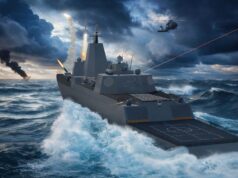
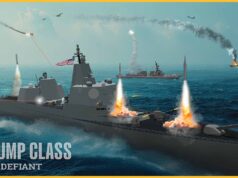
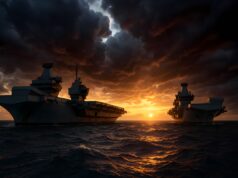
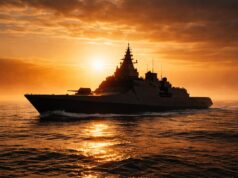

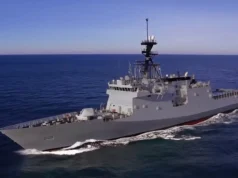
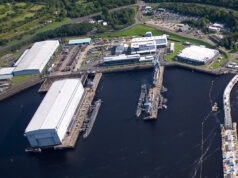

She carries 8 Harpoons?
I noticed that too.
Or is that an older file photo.
Would be a signal that Harpoon is back?
I thought our 23s used to have 8 canisters as standard fit.
Yeah the type 23 all had 8 harpoon launchers fitted as standard. It was standard on the 22 batch 3 as well. The type 45 seemed to get the launchers sometimes from a general pool.
I think the batch 1 and 2 type 22 frigates carried 4 exorcet missiles.
There must be a load of harpoon launchers sitting somewhere. Hopefully they get missiles to fill them soon. I’m firmly in the harpoon camp for the interim anti ship missile. Keep it simple. Still need to look at the price of a harpoon. Obviously the systems to fire and target them will add to the cost. Keep the launchers on all ships even if they are empty. The enemy doesn’t need to know which have missiles in them.
The 45s got the Harpoons from the T22 B3s I believe.
Yes, T22s B1&2 had 4 Exocet forward, no main gun.
fitted with but not for? sounds better than the usual other way around
Did the Type 22/23’s not have Harpoon fitted with some of them being redeployed on the 45’s when ships that had them were decommed?
T45 Harpoon were the sets scavenged from T22 B3.
T23 did have its own sets at least originally.
On the Navy Lookout Twitter feed there is a photo and commentary dated yesterday showing / saying she had 2 harpoons embarked
That is HMS Westminster in preparation for a SINKEX.
Really?
I thought she was on TAPS?
Where did the information come from?
On Navy Lookout.
May two sets of quad launchers?
I count 8 tubes! I don’t think my eyesight is that wonky!!
The number of missiles isn’t disclosed and in any case there won’t be any on board until she has visited the ammunition jetty.
My mistake. The photo on N L I was referring to was Westminster
Maybe only the tubes.
Hms Kent routinely carries a full compliment of Harpoon, as she did on CSG21, she is rare in the Navy fleet in that respect.
I suspect that now the Russian military has shown how poor it is, keeping Harpoon is a good idea as it is now “not” an obsolete system.
harpoon is obsolete not in the fact it’s no longer a viable weapon. But more that it’s not a weapon the RN is every likely to be able to fire due to ROE and risk to other vessels. All missiles of harpoons vintage are effectively a deadly risk to any shipping or land structures in the area it’s fired at. It’s got a history of hitting ships accidentally and blowing up random Norwegian holiday homes. Effectively only countries like Russia can fire these off without concern or somewhere like Ukraine where it’s entire coastline is interdicted by an enemy.
The RN needs a clever weapon it can safely fire in congested seas.
The newest versions of Harpoon with the full Israeli suite of sensors and processors do that just fine.
The ancient version of Harpoon that RN has is, as you say, a very blunt instrument.
But you are comparing 1970’s tech with 2010’s tech and as we all know computers have got a lot smaller and more powerful in those four decades, never mind sensor improvements. Image/profile libraries could be stored on an SD card!!
Hi supportive, yes sorry I should have been clear, I was specifically talking about the block 1C Cold War dinosaurs the RN uses as I had assumed the David was just commenting on keeping those as they can still be used against even older Russian junk. Personally I think there is simply no point keeping those beyond their out of service data as it’s just pissing money into a system a western navy cannot really use ( ROE and risk to wider shipping/ holiday homes). How we replace the present harpoons I think needs to depend on A decision around a realistic strategic direction for the RNs future ASuW capability at present I don’t think senior leaders really have a clue where they want to go and it creates flip flopping. So for me I see a number of possibles:
1) future ASuW will be delivered by the future cruise/anti shipping missile by 2030. Therefore all the RN needs is the most cost effective ASuW option as soon as possible. For me that’s easy you just upgrade your missile stocks to Harpoon block2. That’s probably the cheapest option with least impact on fleet readiness and speed of delivery ( I understand there would be no major refit work for this option).
2) future ASuW being delivered by the future cruise/anti shipping missile for 2030 is a pipe dream and it will not be ready until the lat 2030s or never happen. In this case the interim solution is actually a full generation solution that would be in service for 20 years, so the RN should look for the best present solution ( that’s in operation) that can fill both land and ASuW missions as will as fit in a Mk41 silo.
3) undertake a full Review of what it wants for ASuW and consider other options such as the swarm and EW capabilities of a larger number of spear 3s. The duel function of CAMM and future medium gun solutions. As well as rotor solutions, autonomous systems and Fast jet/patrol aircraft airborne ASuW
Personally I think the whole small number of large and long range heavy weight anti ship missiles On escorts is more about willy waving than optimising the lethality and robustness of your whole kill chain. Let’s be honest an escort that’s stealthy, has good soft kill and hard kill AAW, effective passive sensors, with a good well armed small ship fight, access to plenty of autonomous vehicles with sensors and some form of swarm missile attack carrying its own EW ( spear 3 ) will be death to a more traditional armed escort with 8 Long range heavyweight missiles in almost any type of realistic operation.
It is the lack of a land attack missile that is the issue.
How do you support troops ashore or shut down someone taking pot shots at your shop from beyond NG range?
Yes that’s true and I suppose in this case your looking at what sort of range do you practically need as well as what range can you maintain a kill chain as well as how long your capability lasts. Supporting troops ashore is likely to expend a lot of rounds. So unless your the USN the number of long range heavyweight Options is going to be very limited say 8-12 missiles at most. something like spear 3 could give more bangs ( as long as the range is ok). It’s probably better to have a mixed capability of some longer ranges heavyweight options and lots of more likely range options. Looking at supporting troops on land some form of loitering capability would also be good, autonomous rotors working with the small ship fight. I think these are all the questions the leaders need to sit down and decide ( how long will it take to get these and what sort of time frame can they be delivered in).
My point was more if troops ashore needed rapid support or you needed to take out an enemy battery taking pot shots at the RN ship – like Libya where it was answered with the 4.5” gun. In future the pot shots might be missiles.
For that a few missiles are all that are needed as sending one in at Mach1 will likely suppress and get the opposition to keep their heads down while a drone of helicopter can be tasked.
So it is the close to I instantaneous effect that I think is important for land attack.
Although if there are 6-8 per ship and there is a task group including T31 with VLS and T45 maybe canister launched or Mk41 then there is a decent mass of missiles too.
The missiles themselves will also be past their use by dates, chance of explosive/fuel deteriorating or electrical components failing unless reconditioned. Reconditioning munitions costs 2/3-3/4 the cost of simply replacing.
Good points; both of you. Never considered those. Maybe we should just give the lot to Ukraine?
I think thats what they have been doing with the oldest ones. Certainly what they have been doing with the NLAW and Starstreak missiles where the first ones given have been around 20 years old.
For sure you want to rotate stock.
Why would the Ukrainian’s care if the missiles still have an incredible 90% success rate?
True, but you need to dispose of old missiles too which isn’t cheap.
Or give them to the Ukranians to fire at the Russians? Which I suspect is what is going on as the Ukrainian’s are desperate for anything long range.
Yes that’s a really good use for them to be honest, better than leaving the to rot their last couple of years away doing nothing.
A nice radar upgrade for artisan the article says. I wonder what the upgrade is?
Yes I was wondering that as well.
997 just had a software upgrade to the radar operating and control system. Changes in the operating and control software lead to increases in performance and better signal.processing. You don’t need to change out hardware to improve software controlled systems.
Are refits quicking up?
Definitely seems to be, since the Russian invasion we’ve some how managed to fix up a number that have been in port for years undergoing refit in a matter of months. There’s more of a willingness and need to have them on the water now more than ever since the 1990s.
Notice I wrote quicking? Error, but even quicker than quickening!
Yes. The RN is pushing for shorter refits with more work being undertaken on upgrades and renewals etc being done afloat.
Usually sea valves are 5A to change out which ties into refit periods. however you can do it afloat with divers using coffer dams.
I recently changed out some Vvs on a T23 using this method and previously to that on a Bay.
Thanks. Do like to keep abreast of the critical but less front of house indicators, as you know.
Would be interesting to know during the last 4 months or war in Europe, how many frigates and destroyers have been at sea for how long.
One diesel generator set replaced during maintenance period and another overhauled (50% of units). Logical point to consider implementing PGMU, even if not previously scheduled? Possible impediments might include labor availability, shipyard space/scheduling, requirements scope, fleet duty requirements, MoD cash flow, etc. Request NAB or Gunbuster discuss decision rationale.
The current Paxman DGs can be changed out afloat in a few weeks. PGMU is a massive undertaking. New foundations, pipework, enclosures, control systems etc…with the need for longterm planning and new DG set provision you cannot cuff it and suddenly decide to do it.
The shipping routes into the machinery spaces take out a lot of real estate and limit access inside the ship as well.
Gunbuster,
Thanks, appreciate the prompt and comprehensive explanation. 😊